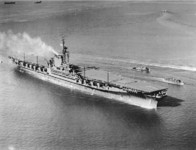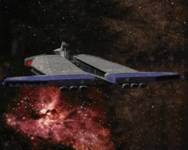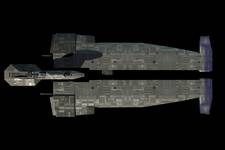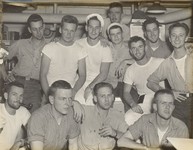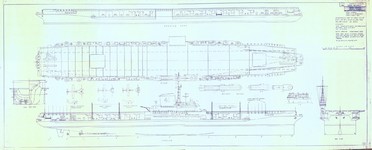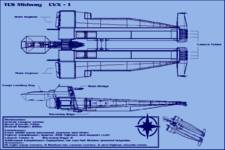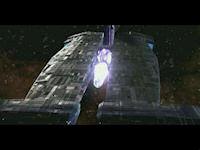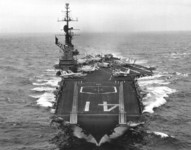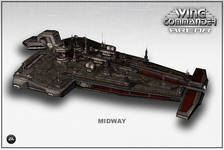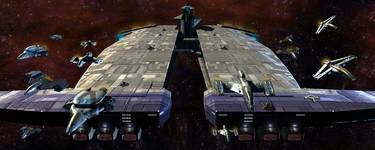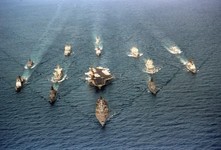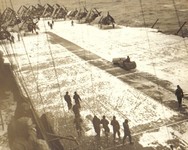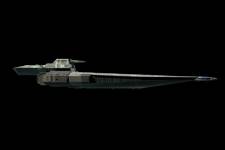Bandit LOAF
Long Live the Confederation!
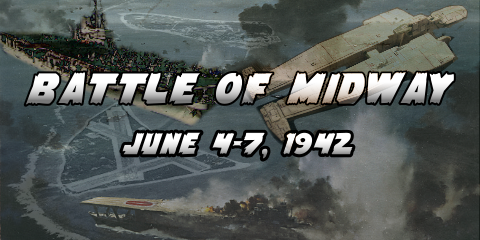
The megacarrier program was developed in the mid-2670s as a more efficient peacetime alternative to the massive Vesuvius-class carriers then being built. The new megacarriers would outclass Vesuvius and aging war-era ships, not by offering superior firepower, but instead by acting as mobile starbases capable not only of fighter operations but a wide range of roles.
Megacarriers would support three full fighter groups, 252 fighters and strike craft in total, capable of operating independently or in coordination. They would also carry equipment to support two full armored TCMC brigades, with a 1,500-man Marine Expeditionary Unit aboard at all times. Megacarriers would be the first warship ever to field a dedicated Science Division, a cross between a colonial scientific extension ship and a naval intelligence field station. The 120-person multi-service division would be able to go from solving agricultural problems at Confederation colonies to conducting lightning fast intel analysis.
Finally, the ships would would act as HQ for battle commanders, command-and-control centers for strategic planning and communications hubs for support ships. Total crew would range from six to seven thousand depending on mission. The ships would be capable of putting to space for longer than previous carrier designs. In short, mobile starbases during peacetime capable of dealing with a wide variety of crisis which could instantly form the nuclei of strike forces or carrier groups should war come.
The 27th century wins this round. By a lot.
Newly developed megacarrier doctrine claimed that the warships would be more efficient than those which had come before: cheaper to build than their equivalent capacity of multiple war-era ships and easier to defend by focusing protection on a single hull rather than multiple carriers, marine transports, command and control ships and science vessels. The design, whose funding was the source of constant in-fighting in the Senate, would save credits by reducing armor and thus overall tonnage from the Vesuvius-class--but would boast the shields of wartime top-security permanent installations, capable of rendering them nigh invulnerable. A new system of arterial fighter storage, which divided launch operations through a network of tubes and into six independent launch bays, would lessen the impact of the catastrophic suicide attacks against flight decks used by the Kilrathi. Megacarriers would be defended by an array of lasers, missile turrets for anti-fighter work and ion cannons and capship missiles for heavier fighting. In all, the design would weigh in at 1,830 meters in length and 200,000 tonnes.
In 2676, the chairman of the Senate's Armed Forces Committee, James Taggart, approached Brigadier General Christopher Blair to ask that he return to active military duty as chief military liaison for the megacarrier project. As Senior Operational Consultant on the project, Blair would follow the design from space engineering blueprints to the christening of the first ship at TSY Archology and on to fifty days aboard her final shakedown cruise. The historic name chosen for the class? Midway.
TCS Midway (CVX-1) was the lead ship of the Midway-class heavy carriers and the first of the Terran Confederation's vaunted "megacarriers". Midway began her career conducting anti-piracy operations on the frontier as part of her final shakedown. History would soon intervene, having left her in the 'right place at the right time' during the initial Nephilim invasion. Midway, along with the Eisen carrier group, would fight her way to the core of the Nephilim hordes in the Kilrah System and destroy the alien's wormhole gate.
Both Midways made use of their science division! Here, Wernher von Braun conducts a 1947 carrier-based V2 rocket firing onboard USS Midway.
The initial production run of ten Midway-class ships would go on to serve with distinction throughout the violent Nephilim War, with later ships of that set differing slightly visually as the "Flight IIA" model. All ten were named after great naval battles: Midway, Mistral Sea, Tafanda Bay, Coral Sea, Jutland, Ptoloman's Rift, Enyo III, Bataan, Tripoli and Port Broughton. Port Broughton survives to this day, operating as a makeshift refugee waystation on the frontier.Then, there's the real thing. USS Midway (CVB-41) was America's first Battle Carrier (CVB - C for Carrier, V for Heavier-than-Air, B for Battle), also the lead ship of a Midway-class. She was the first American carrier to possess an armored flight deck. On all prior American carriers the flight deck had been made of Teak, which prevented splintering. British carriers had long had armored flight decks, they actually had fully armored hangars on some ships. However, these carriers had fairly small air wings (36-48 aircraft). The Japanese built an armored deck carrier during the war, Taiho. Taiho was sunk by the American submarine Albacore during the Battle of the Philippine Sea (June 19, 1944) and never got a chance to see what her armored deck could take. Unlike the British and Japanese carriers, the Midway was designed with a large air group in mind. When fully loaded she could accommodate 130 World War II era Hellcats, Corsairs, Avengers and Helldivers. The desire to operate such a large air group necessitated the massive size of the carrier. USS Midway displaced 45,000 tons standard displacement. That's the same as the Iowa class battleships at standard displacement! The USS Midway's career is marked with research and development operations. The ship itself was no exception.
USS Midway, named for the famous 1942 battle, was laid down on October 27, 1943. Her hull is based on the design that would have become the Montana class battleships, although they were cancelled in favor of building more Essex class carriers following the battles of 1942. When she was commissioned, eight days after Japan's surrender, on September 10, 1945 she became the first US Navy warship that was too large to use the Panama Canal.
The Midway began her shakedown cruise in the Caribbean before she joined the Atlantic Fleet as the flagship of Carrier Division 1. It was during this period of her career, September 1947, that the Midway took part in Operation Sandy. During the operation she launched a captured German V-2 rocket (launched by Werhner von Braun himself). This was the first launch of a V-2 from a moving launch platform. For the next seven years the Midway operated with the Atlantic Fleet before transferring to the 7th Fleet in the Western Pacific in 1954. A year later she entered dry dock for her first modernization. She received new catapults, elevators and most importantly an angled flight deck for simultaneous launch and recovery operations. She rejoined the 7th Fleet in 1957 and would remain in the Pacific for the rest of her career.
At the start of the Vietnam Conflict USS Midway was deployed to the Far East to support American operations. Commander L. C. Page flying an F-4B Phantom with VF-21 shot down a MiG-17 on June 17, 1965. This was the first American MiG kill in the Vietnam Conflict. For their performance on this cruise, Midway and her air wing, Attack Carrier Air Wing Two, received the Navy Unit Commendation Medal and, in addition, Midway received the Battle Efficiency "E," marking her as the outstanding carrier in the Pacific Fleet. Following this tour the Midway underwent the most extensive modernization of any ship in American naval history.
The flight deck was enlarged from 2.8 to 4 acres! New and larger elevators were installed to handle the ever increasing size of naval aircraft. Along with countless other improvements (at the cost of a cool $202 million), the Midway was ready to rejoin the Fleet in January 1970.
She was sent back to the Far East where she stayed on station until 1973. On January 12, 1973 LT V. T. Kovaleski and LT J. A. Wise, flying an F-4B Phantom II shot down a MiG-17. This was the last air-to-air kill in the Vietnam conflict. Quite a book end! For services rendered in Vietnam, the USS Midway received a Presidential Unit Citation. However, the Midway's, perhaps, most famous operation in Vietnam came in April 1975 when Major Buang, along with his wife and five children, flying a Cesena 0-1 Bird Dog observation plane flew from a base in South Vietnam into the Gulf of Tonkin hoping to find a carrier to land on. In an amazing bit of flying, Major Buang landed on the Midway lacking the proper equipment to do so. One officer said Buang came in a perfect glide scope and had he had an arresting hook would have grabbed the third wire (the preferred one) without question.
The Midway continued to serve the US Navy into the 1990s when again the carrier went into combat in the Persian Gulf. From November 1990 until February 1991 the Midway launched strikes against Iraq in support of Coalition forces. She went to Yokosuka later that year. She would soon be back off to the United States for her final voyage.
On April 11, 1992 USS Midway was decommissioned in San Diego. It would be more than a decade before USS Midway would make her final deployment in 2003 to become a museum and memorial in San Diego. Seven years ago today, on June 7, 2004 the USS Midway museum opened to the public. It became an immediate success drawing far more visitors than was predicted. She continues to be a popular destination for those visiting the area.
Space looks like the warmer alternative.
What do either of these ships have to do with the Battle of Midway? Well, only the name. It certainly made sense in 1943 to name a new carrier after a great victory in the current war... and it's a testiment to the enduring importance of the battle that the name would still be relevant 738 years later. More than that, though, the fact that both carriers represent massive new strides in Naval aviation are something borne out of the Battle of Midway's legacy. The importance of carrier warfare was confirmed for all time on June 4, 1942--and whether it was the United States of America or the Terran Confederation investing in a new class of carriers built on the bloody lessons of their war experience, doing so was still a tacit acknowledgement of the lessons of Midway.Very special thanks to this update (and series)'s history author, Dundradal.
--
Original update published on June 7, 2011
Last edited by a moderator:

